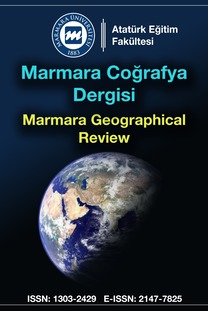MEKÂNSAL DÜŞÜNMENİN TÜRKİYE'DE SOSYAL BİLGİLER ÖĞRETİM PROGRAMINDAKİ YERİ VE ÖĞRETMENLERİN BU BECERİ HAKKINDAKİ GÖRÜŞLERİ
Bu araştırma, Sosyal Bilgiler öğretim programında kazandırılması hedeflenen bir düşünme becerisi olan mekânsal düşünmenin Sosyal Bilgiler öğretmenlerinin Araştırmada, nitel araştırma yöntemlerinden durum çalışması kullanılmıştır. 2014-2015 öğretim yılı güz döneminde Niğde'de görev yapan 12 Sosyal Bilgiler öğretmeni ile görüşülmüş ve onların mekânsal düşünmenin farklı boyutları ile ilgili görüşleri alınmıştır. Öğretmenler tesadüfi örneklem yöntemiyle seçilmiştir. Araştırmada veriler yarı-yapılandırılmış görüşme formu ile toplanmıştır Araştırma kapsamında elde edilen verilerin çözümlenmesinde içerik analizi türlerinden tümevarımcı analiz kullanılmıştır. Sosyal bilgiler öğretmenleri mekânsal yararlandıklarını belirtmişlerdir. Sosyal bilgiler öğretmenlerinin mekânsal konularda en çok kullandıkları materyaller harita ve basılı materyaller (fotoğraf, resim vb), en çok kullandıkları yöntemler ise anlatım, soru-cevap, örnek vermedir. Öğrencilerin hazırbulunuşluluğu, sosyo-ekonomik düzeyi ve konuya ilgisi mekânsal düşünme becerisini en çok etkileyen faktördür. Araştırma sonunda genel olarak Sosyal Bilgiler öğretmenlerinin mekânsal düşünmeyi Sosyal Bilgiler öğretiminde her ne kadar gerekli ve önemli görseler dahi bu beceriyi kazandırma adına diğerlerinden farklı bir etkinlik ya da materyallerinin olmadığı görülmüştür.
The Placing of Spatial Thinking in Turkish Social Studies Education and Social Studies Teachers' Opinion about this Issue
This study aims to evaluate Social Studies teachers' perspectives about spatial thinking skill which is placed in Turkish Social Studies Curriculum. A qualitative research designed and interviewed with 12 Social Studies teachers who work in Niğde in 2014-2015 academic year for get their opinions about different dimension of spatial thinking. The interview form consisted of five openended questions. Teacher opinions were examined by content analyses. Inductive analysis was used in analyzing data obtained from the content analysis research. Social Studies teachers indicated that they benefit from technology tools in the process of developing spatial thinking. Social Studies teachers stated that they use projectors, animation, drawing visuals etc. and according to them these materials affect the students' spatial thinking skills. Social Studies teachers preferred to use traditional lecture, questioning and case study techniques most commonly for spatial issues. According to Social Studies teachers, student characteristics are also involved in the spatial thinking skills education. Students' knowledge background, their social-economic level and their interest in the subject appear to be the most important factors. Result of the research show eventhough Social Studies teachers see that spatial thinking important and necessary in the Social Studies teaching, they can use some materials and methods which are generally used in other subject teaching as well.
___
Aktürk, V. Yazıcı H. ve Bulut R. (2013). "Sosyal Bilgiler Dersinde Animasyon ve Dijital Harita Kullanımının Öğrencilerin Mekânı Algılama Becerilerine Yönelik Etkileri", Marmara Coğrafya Dergisi, Sayı: 28, s. 1-17.Alparslan, A. M. ve Çarıkçı, İ. H. (2014). "İşletmede Strateji Oluşturma Yaklaşımlarını Değerlendirmeye Yönelik Bir Vaka Çalışması", YÖNETİM: İstanbul Üniversitesi İşletme İktisadı Enstitüsü Dergisi, Sayı:76, s. 18-44.
Association of American Geographers, (AAG), (2014). American Introducing Spatial Thinking Skills Across The Currıculum, (available at online from http://www.aag.org/galleries/tgmgfiles/spatial_thinking_history_lesson.pdf, 05.18.2014)
Audet, R. ve Ludwig G. (2000). "GIS In Schools", Redlands,CA.: Esri Pres.
Bahar, H. H. Sayar, K. ve Başıbüyük, A. (2010). "İlköğretim Öğrencilerinin Kroki Okuma Becerilerinin İncelenmesi (Erzincan Örneği)" Fırat Üniversitesi Sosyal Bilimler Dergisi, Cilt: 20, Sayı: 1, s. 229-246.
Bednarz, S.W. (2007). Mapping The Way Forward in An Uncertain World: Spatial Thinking and Geography. In S. Catling and L. Taylor (eds.) Proceedings in changing geographies: Innovative curricula. London: Institute of Education, University of London; p. 13-28.
Çelikkaya, T. ve Kuş, Z. (2009). "Sosyal Bilgiler Öğretmenlerinin Kullandıkları Yöntem ve Teknikler" Uludağ Üniversitesi Eğitim Fakültesi Dergisi, 22 (2), s. 741-758.
Doğan, C. (2004). "Sınıf Öğretmenlerinin Derslere İlişkin Görüşleri ve Tercih Ettikleri Öğretim Yöntemleri İstanbul Örneği" Türk Eğitim Bilimleri Dergisi 2(2), 193-203.
Eisenberg, A. N. (1999). An Educational Program For Paper Sculpture: A Case Study In The Design of Software to Enhance Children's Spatial Cognition, Unpublished Doctorate Thesis, Colorado Unv: Department of Computer Science.
Gryl, I. ve Jekel, T. (2012). "Re-centring Geoinformation in Secondary Education: Toward a Spatial Citizenship Approach" Cartographica, 47(1), p. 18-28.
Johansson, T. (2003, June). GIS in teacher education - Facilitating GIS Applications in Secondary School Geography. K. Virrantaus and T. Håvard (Ed). The 9th Scandinavian Research Conference on Geographical Information Science (p.285-293). Finland: Helsinki University of Technology.
Köşker, N. (2012). "Sınıf Öğretmeni Adaylarının Mekânsal Biliş Yeterliliklerine Ilişkin Düşünceleri" Journal of World of Turks, 4(3), s. 161-173.
Lee, J. ve Bednarz, B. (2009). "Effect of GIS Learning on Spatial Thinking" Journal of Geography in Higher Education, 33(2), s. 183-198.
Lee, J. ve Bednarz, B., (2009), "Components of Spatial Thinking: Evidence from a Spatial Thinking Ability Test", Journal of Geography, Sayı: 111, s.15-26.
Linn, M. C. ve Petersen, A.C. (1985). "Emergence and Characterization Of Sex Differences in Spatial Ability: A Meta-Analysis" Child Development, 56(6), p. 1479-1498.
Kim M. ve Bednarz R. (2013). "Development of Critical Spatial Thinking Through GIS Learning" Journal Of Geography In Higher Education, 37(3), 350-366.
Madsen, L. M. ve Rump C. (2012). "Considerations of How to Study Learning Processes when Students use GIS as an Instrument for Developing Spatial Thinking Skills" Journal of Geography in Higher Education, 36 (1), s. 97-116.Miles, M.B. ve National Curriculum Standards for Social Studies (NCSS, 2014). The Themes of Social Studies Published on National Council for the Social Studies, (http://www.socialstudies.org).
Newcombe, N. S. 2010. "Increasing Math and Science Learning By Improving Spatial Thinking" American Educator, s. 29-36.
Schultz, R. B., Kerski, J. J. ve Patterson, T. C. (2008). "The Use of Virtual Globes as a Spatial Teaching Tool With Suggestions For Metadata Standards" Journal of Geography, p. 27-34.
Yıldırım, A. ve Şimşek, H. (2005). Sosyal Bilimlerde Nitel Araştırma Yöntemleri. Ankara: Seçkin Yayınevi.
Qiu, X. (2006). Geographic Information Technologies: An Influence On The Spatial Ability Of University Students. Unpublished doctoral dissertation, Texas State University.
- ISSN: 1303-2429
- Yayın Aralığı: Yılda 2 Sayı
- Başlangıç: 1997
- Yayıncı: Marmara Üniversitesi
Sayıdaki Diğer Makaleler
NİHAL BALOĞLU UĞURLU, ELİF ALADAĞ
İSTANBUL ADALARI'NDA BEŞERİ ORTAM KOŞULLARINA AİT SORUNLAR VE YÖNETİMİ
NURİYE GARİPAĞAOĞLU, Sibel ÖZCAN
TÜRKİYE'DE İLÇELERİN VE 2012 YILI İLÇE NÜFUSLARININ YÜKSEKLİK VE KIYI YAKINLIĞINA GÖRE ANALİZİ
Ahmet KARABURUN, Mehmet KARAKUYU
TÜRKİYE'DE HABER KANALLARINDA HARİTA KULLANIMI
